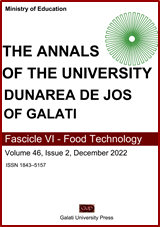Ultrasound assisted extraction of carotenoids from green and orange biomasses of Dunaliella Salina DunaDZ1
Abstract
Microalgae are described as a potential alternative source of bioactive compounds that are environmentally friendly. Dunaliella on its own is well known due to its potential to accumulate large amounts of carotenoids, especially β-carotene. Green and orange biomasses from a new Dunaliella salina strain DunaDZ1 isolated from an Algerian Salt Lake were evaluated for carotenoids composition and antioxidant activity. Ultrasound-Assisted Extraction (UAE) was employed using different extracting solvents. Furthermore, UAE extracts were then analyzed for their chemical composition by TLC, HPLC-DAD and for the antioxidant activity. Lutein was the main carotenoid in the green biomass, with the highest amount for ethyl acetate extract (393.19 mg/g). However, for the orange biomass, the main carotenoid was trans, β-carotene (131.83 mg/g) in the acetonic extract. Moreover, several others carotenoids were detected, belonging to xanthophylls and carotenes. Additionally, ultrasonic-assisted extraction with ethyl acetate produced the extract with the highest antioxidant activity for both D. salina biomasses. These extracts could be used as a natural antioxidant and as an ingredient for functional foods formulation.


